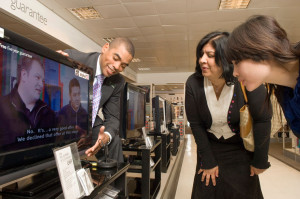 When it comes to retail, there are a great many decisions that need to be made at all different levels of management. Before the advent of automated intelligence gathering this would all have to be done manually, and it could take weeks for the data to work its way up from the employee level to management.
When it comes to retail, there are a great many decisions that need to be made at all different levels of management. Before the advent of automated intelligence gathering this would all have to be done manually, and it could take weeks for the data to work its way up from the employee level to management.
Nowadays, a custom, unified dashboard can be created by a savvy BI team to manage all aspects of a retail chain’s performance, with layers starting with each individual employee and expanding all the way out to the national level. This kind of reporting system gives executives a complete picture of the functioning of their brand, and allows them to make informed and detailed decisions at both a regional and national level in real time.
At the most basic level of store reporting you have the individual employees logging their sales through a customized mobile app. This allows them to see how they’re performing against their peers, essentially gamifying the sales experience, as well as participating in employee satisfaction surveys and gathering other important employee metrics. An added perk to gamification is that it has been shown to lead to an increase in same-store sales.
At the store level a reporting app provides managers with tools to capture employee performance and sales, allowing them to effectively manage their employees based on their sales. This also allows store managers to implement simple “employee of the day” awards and other incentives to keep their employees performing at their peak. The app can also have the added benefit of keeping track of which items are selling well by each employee, giving managers direction for their sales meetings.
All the information provided at a store level gets uploaded to the franchise database and updates the dashboard, providing up to the minute action-able insights on how a brand is performing on a large scale. Regional managers can then look at the performance of all of the stores in their territory by the numbers. However, by incorporating a data mapping tool such as GeoDash, which in itself incorporates Google Maps, would also allow them to see how the stores are performing against external factors affecting sales such as traffic, weather and the proximity of competitors. Maps can even be configured to show the proximity of events such as crime or construction to see how that impacts the brand.
Finally, the big decision makers can look at store performance on a state / provincial or national level using the same map generated by GeoDash. Zooming out and seeing the performance of stores reflected in a traffic light scale allows for a quick and easy overview of the regions which are performing well, and then the tool allows for a deeper dive into what might be the cause. What’s more, because GeoDash is fully integrated with Google Maps, decision makers who are not familiar with the area of a store can even utilize Google Street View to scope out the area surrounding a store.
Automated data analytics takes what once was a laborious manual process and streamlines it into a database that incorporates information from all touchpoints in all stores, giving decision makers a full picture of the performance of their brand.
In our next blog we’ll explore how retailers can integrate their market basket analysis and planograms into a single dashboard to make smarter purchasing and layout decisions.
More Blogs on Retail:
1. The Value of Dashboards for Store Reporting
2. Market Basket Analysis and Planograms
3. Privacy and Consumer Data
4. Personalizing the Shopping Experience

